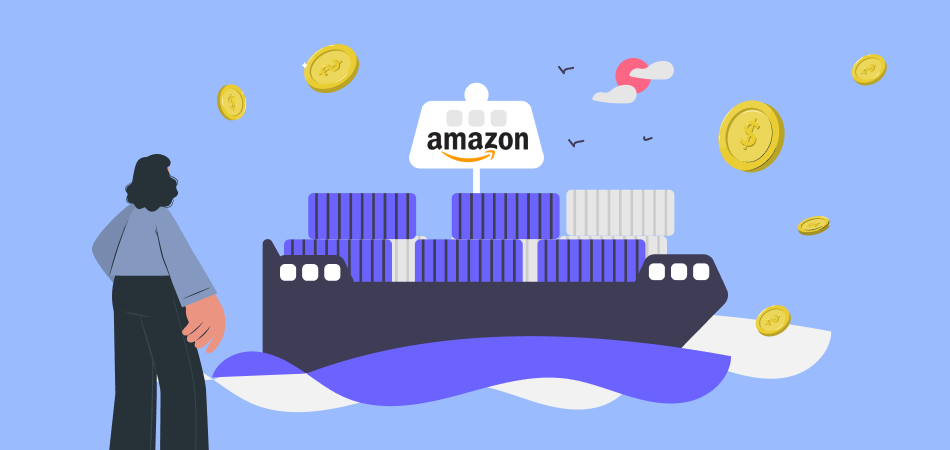Why Is Amazon Shipping So Slow Even with Prime? A Deep Dive into Amazon Logistics

Amazon Shipping, known for fast delivery with Prime, has been experiencing delays lately. Some Prime members experience longer-than-promised delivery times and unexpected delays. This article examines Amazon's slower shipping and its impact on Prime membership.
Why Fast Shipping Is Important
Fast shipping plays a crucial role in the success of any e-commerce business. Here are several reasons why quick delivery is essential for maintaining customer satisfaction and driving sales.
1. Enhanced Customer Experience
In today’s fast-paced world, customers expect quick results. Fast shipping satisfies this desire, providing a sense of instant gratification that can lead to positive shopping experiences.

|
Pre-set the Best Shipping Methods DSers Shipping Settings - Pre-select your favorite shipping method to save money and time |
Customers often feel anxious about the status of their orders. Quick shipping alleviates this concern, making them feel secure and valued.
2. Increased Customer Loyalty
Customers are more likely to return to your store if their initial experience was positive, particularly regarding shipping speed. Fast shipping can cultivate a loyal customer base.
Satisfied customers are more likely to recommend your business to friends and family, which can lead to increased sales and a larger customer base.
3. Competitive Advantage
In a crowded market, offering faster shipping can set your business apart from competitors. Customers may choose your store over others simply for the promise of quicker delivery.

|
Tracking Number with Auto Sync Auto Sync Tracking Numbers - Automatically sync the tracking number from AliExpress to your store |
Highlighting fast shipping in your marketing efforts can attract new customers who prioritize speedy delivery when making purchasing decisions.
4. Higher Conversion Rates
Slow shipping times can lead to cart abandonment. Customers may leave their carts if they see lengthy shipping times, which can impact your overall sales.
By offering fast shipping options, you can enhance the checkout experience, leading to higher conversion rates and increased sales.
5. Positive Brand Image
Fast shipping demonstrates reliability and professionalism. Customers are more likely to trust brands that can deliver their orders quickly and efficiently.
A strong reputation for fast shipping can elevate your brand image, positioning your business as a leader in customer service.
6. Reduced Returns and Customer Complaints
Quick shipping reduces the likelihood of returns due to delays or dissatisfaction. When customers receive their orders promptly, they are less likely to be disappointed.
Fast shipping minimizes the number of customer inquiries regarding order status, allowing you to focus on other aspects of your business.
Why Is Amazon Shipping So Slow
Let’s figure out the reasons why the shipping is so slow even with Amazon Prime.
1. Increased Demand and Order Volume
Amazon's popularity surge has led to a high volume of orders daily, overwhelming its logistics system. This problem intensifies during peak shopping seasons, such as holidays.

|
Place Orders to AliExpress In Seconds DSers Bulk Order - Place 100s of orders to AliExpress in a few seconds with a just few clicks |
2. Supply Chain Disruptions
Timeframe interruptions in global supply chains have become extremely serious in recent years, affecting air traffic instances and geopolitical challenges, as well as shipping constraints.
Amazon experienced supply chain disruptions, leading to delays in delivery and overuse of resources. Customers are used to Amazon for the fast shipping of products. The supply chains around the world are still feeling the effects of the lingering pandemic.
Global supply networks became weaker. Political crises, natural disasters, and sudden energy issues caused this. Many other retailers including Amazon rely on suppliers and manufacturers all over the world.
Amazon's performance suffers when its manufacturer will get production or shipping troubles. Amazon fails to properly fulfill orders and stock adequate products.
3. Labor Shortages
Amazon's operations rely on millions of employees who handle shipping. Labor shortages in delivery networks and warehouses have slowed down operations. A lack of warehouse staff and delivery personnel has led to longer production times and missed delivery targets.
Shipping times can indicate workforce shortages. Amazon's distribution infrastructure needs a smooth workforce operation. Employee recruitment is challenging, especially during peak times like Black Friday.
Operations have slowed due to high employee turnover, discontent, and wage requests. Labor strikes and protests have halted normal order management and delivery operations at distribution centers.
4. Changes in Amazon’s Delivery Prioritization
Amazon prioritizes essential items during emergencies and global disasters. Prime members are dissatisfied when their urgent orders are not fulfilled promptly.
These changes may sometimes result in shipping time divergences which can be frustrating for Prime customers who are used to two-day shipping. Why is Amazon shipping so slow is a question that is often asked by customers who receive these delays.
5. Increased Dependence on Third-Party Sellers
Through Amazon's marketplace, the third-party vendors can interact directly with the customer, and take care of their shipping and logistics. Delays occur when these vendors fail to meet Amazon's delivery standards.

|
Find Better Supplier For Products DSers Supplier Optimizer - One click to filter out the most proper suppliers for your products |
Items shipped by third-party sellers to Amazon Prime criteria may take longer compared to those dispatched from Amazon's storage facilities.
6. Weather and Natural Disasters
Amazon has a delivery network. These events can postpone transport sports. These events can delay transport activities. The bad weather is out of Amazon's control, even though it may make shipping take longer.
7. Issues with Last-Mile Delivery
Shipping can be challenging when packages are delivered to regular recipients by local couriers. Delays at this stage are often due to poor courier services, traffic issues, and address problems.
8. Regional Variations in Delivery Speed
Amazon uses different delivery systems worldwide. Rural and remote areas experience slower delivery compared to urban areas due to the more advanced delivery infrastructure in cities.
9. System Glitches and Errors
Shipping delays often occur due to shop errors, shipping estimate errors, and improper order processing. Amazon may also experience issues such as faulty software, low stocks, technical problems, incorrect delivery time estimates, and occasional package loss.
10. Algorithmic Shipping Prioritization
Amazon handles shipping until it's passed to the shipping company. Order fulfillment depends on warehouse location, market demand, and buyer behavior. Delivery timing ranges from immediate to delayed due to logistics planning.
11. Changes in Prime Shipping Terms
Amazon has changed its shipping terms for Prime members. Initially, they promised two-day shipping, but now they offer "fast free delivery" for more flexibility. This change lets Amazon add extra days to shipping without breaking their promise.
12. External Carrier Delays
Amazon uses outside carriers like USPS, FedEx, and UPS, in addition to its own logistics programs for some deliveries. If these carriers face backlogs, staffing problems, or weather delays, Amazon's delivery performance may suffer. Shipping delays increase when issues affect the third-party logistics system that Amazon cannot control.
What Does Amazon Do to Prevent Shipping Delays
Amazon is trying to enhance its logistics and solve delivery delays through several methods.
- Operational Expenses: Amazon is creating new fulfillment centers to enhance storage capacity and minimize the distance between products and customers.
- Boost Automation/Robotics: Machine-loaded and automated warehouse/robot systems get orders quickly out of nursing labor.
- Building Its Delivery Fleet: Amazon is expanding its transportation network. It relies less on third-party suppliers.
- Fulfillment in a day, and the Regional Fulfillment: Amazon is testing pilot performance Regional processes and shipping, especially, in areas of high demand.
- Promoting Customers' Options for Consolidated Deliveries: Amazon can optimize its delivery routes by consolidating several items into fewer shipments. This helps reduce pressure on its logistics system.
What Customers Can Do to Minimize Delays
Amazon is working on faster shipments. Customers can help by taking a few precautions to prevent delays and receive their shipments on time.
- Choose Amazon Day Delivery: Prime members can select the delivery day of the month they prefer, which helps in organizing deliveries efficiently and reducing empty slots.
- Order Ahead Of Time During Peak Times: Buy the item you need for an event several months in advance to avoid shipping delays during busy times.
- Select In-Store Pickup Options: You can find products at an Amazon Fresh Store, or at partner locations like Whole Foods today.
- Double-check your Address & Delivery Preferences: Ensure that you supply the accurate address and delivery preferences to avoid mail misdirected as well as delayed.
The Future of Amazon Shipping
Amazon continues to invest in the latest technologies and shipping solutions in the hope of solving shipping problems. Drone delivery, autonomous vehicles, and AI-powered sorting systems for warehouses are all part of Amazon's extensive plan to dominate e-commerce logistics.
However as the company becomes more efficient, customers may need to be realistic. Two-day delivery on every item is probably no longer normal, and delays can still happen during busy periods or regular business disruptions.
Conclusion
Amazon delivery delays are caused by a combination of factors: high order volume, supply chain disruptions, labor shortages, and changes in delivery operations. Prime membership does not cover delays due to weather or third-party issues.
Customers should be prepared for longer wait times. Amazon is continuously improving its processes to expedite deliveries. The company faces challenges in delivering Prime orders on time. The complexity of Amazon's logistics network contributes to shipping delays.











 Company
Company
 Why Choose DSers
Why Choose DSers
 Blog
Blog
 Help Center
Help Center




 Live Chat
Live Chat